-
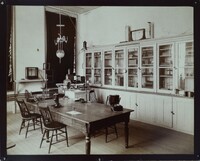 Higher Physics First Floor - Room 31
Higher Physics First Floor - Room 31 This image depicts a higher physics classroom full of scientific instruments but void of people. Physics and Chemistry were the two main subjects taught in the Physical Sciences department, and both of these subjects involved a lot of hands-on experimentation in the Normal School’s laboratory rooms. The Normal offered five courses relating to the subject of Physics, all of which prepared students to go on to teach physics at the high school level. The Normal register notes that to be a successful Physics student one had to not only experiment, but also “make a special study of apparatus and manipulation and have some practice in demonstration in the presence of a class” (p.55).
-
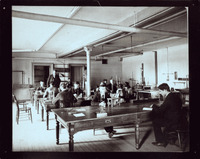 Fred Gorton, Physical Sciences class
Fred Gorton, Physical Sciences class This image depicts one of the Physical Sciences classes being led by the man who is standing at the back of the classroom appears to be Frederick R. Gorton. Gorton graduated from the Michigan State Normal School in 1892 at the age of 21, and immediately joined the Physical Sciences department faculty. Starting his career at the Normal as an instructor, Gorton eventually went on to receive a Ph.D. from the University of Berlin, Germany, and then worked as a professor at the Normal until his retirement in 1941.
-
 Empty Physics Laboratory
Empty Physics Laboratory This image depicts an empty Physics laboratory, with apparatuses that students used to learn about electricity. According to the 1892-93 Normal Register, Electricity and Light was taught during the second term of the Elementary Physics course. In this course, the purchase, testing, care, and effective use of apparatus was given considerable attention. Hands-on experimentation was prioritized in the physics courses, and all students were expected to demonstrate their knowledge of apparatus manipulation in the presence of a class.
-
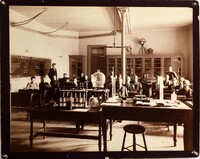 Elementary Physics First Floor - Room 30, Prof. Gorton
Elementary Physics First Floor - Room 30, Prof. Gorton This image depicts an Elementary Physics class being taught by Professor Fred Gorton. The Physical Sciences occupied the majority of Gorton’s free time, which is evident in the fact that, in addition to serving as a part of the Physical Sciences Department, Gorton was a member of the Sociétéde Physique (Physical Society) and the American Academy for the Advancement of Science (Aurora, 1912, p. 49). Fred remained a part of the Michigan State Normal College’s faculty for 50 years, retiring only a few years before his passing.
-
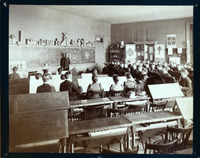 Drawing 2nd Floor - Room 57.
Drawing 2nd Floor - Room 57. This image depicts the same drawing class depicted in 4-4 from a different perspective. The class in the photograph is likely an elementary level drawing class as there was a focus on geometrical shapes. The elementary class was a modified version of the Drawing curriculum given to Training School students, and was designed to prepare students to teach basic art lessons at the Elementary level. Subsequent Drawing courses built upon the principles taught in the elementary coursework, and senior students would teach lessons to the Training School students under the supervision of the department head for practice.
-
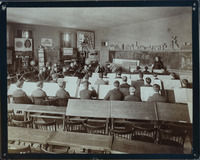 Drawing 2nd Floor - Room 51.
Drawing 2nd Floor - Room 51. This image depicts a Drawing class, likely being taught by Charles T. McFarlane before he officially joined the Drawing department. The sole faculty member of the Drawing department listed in the 1892-93 register, John Goodison, passed away sometime around October 1892, a few months before this picture would have been taken. Goodison had been a part of the Normal faculty since 1861, and was highly regarded by both staff and students alike. He was described as being patient no matter the circumstance, and he always had words of encouragement for his students regardless of their talent level.
-
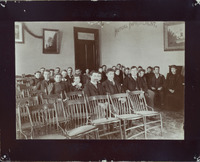 Crescent Society First Floor - Room 5.
Crescent Society First Floor - Room 5. This image depicts a meeting of the Crescent Society, which was the last club added to the Lyceum Societies in the spring of 1882. A part of the society's motto,“Mutual Improvement, Mutual Enjoyment,” can be seen on the wall in the photograph. This motto was chosen because Crescent Society members believed that genuine improvement and enjoyment is not found alone, but with companions. With this in mind, the purpose of the Crescent Society was for members to practice expressing their thoughts in a group setting rather than solely focusing on independent thought and study. - (Aurora 1893, p.77).
-
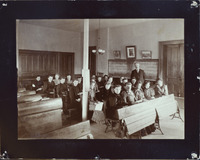 Conservatory Recitation & Lecture Room First Floor.
Conservatory Recitation & Lecture Room First Floor. This image depicts a class being taught in the Conservatory Recitation and Lecture room by the Director of the Conservatory Frederic Pease. Music was a required course for graduation. While the Music course offered by the Normal was free, students who wished to receive advanced voice or instrument training had to pay to take courses in the Conservatory. Students who wanted to join the Normal Choir were required to have passed the music course, in which they were taught how to read music and cultivate their voices.
-
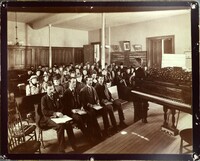 Conservatory - Recitation & Lecture Room First Floor - Room 61.
Conservatory - Recitation & Lecture Room First Floor - Room 61. This image depicts a class being taught in the Conservatory under the direction of instructor Oscar Gareissen. The Conservatory provided a regular four-year course leading to a teaching certificate, and also offered advanced instruction in either vocal or instrumental music. The three instruments available for students to choose from were the piano, violin, and organ. Students who proved to be competent with their instruments were given opportunities to accompany the vocal students and play their own recitals.
-
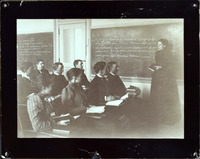 Classical Languages 2nd Floor Room 45.
Classical Languages 2nd Floor Room 45. This image depicts a Latin language class being taught by Helen B. Muir, who acted as Benjamin D’Ooge’s assistant in the Ancient Languages Department. Due to the fact that “Caesar” can be seen on the chalkboard, it is likely that this was a second year Latin class as the curriculum focused heavily on Caesar’s commentaries. According to the 1892-93 Normal register, “the reading of some good biography of Caesar” was also required. Four years of Latin lessons were offered to all Normal students, but advanced courses were only offered to students pursuing the advanced courses leading to the degree of Bachelor of Pedagogics.
 Higher Physics First Floor - Room 31 This image depicts a higher physics classroom full of scientific instruments but void of people. Physics and Chemistry were the two main subjects taught in the Physical Sciences department, and both of these subjects involved a lot of hands-on experimentation in the Normal School’s laboratory rooms. The Normal offered five courses relating to the subject of Physics, all of which prepared students to go on to teach physics at the high school level. The Normal register notes that to be a successful Physics student one had to not only experiment, but also “make a special study of apparatus and manipulation and have some practice in demonstration in the presence of a class” (p.55).
Higher Physics First Floor - Room 31 This image depicts a higher physics classroom full of scientific instruments but void of people. Physics and Chemistry were the two main subjects taught in the Physical Sciences department, and both of these subjects involved a lot of hands-on experimentation in the Normal School’s laboratory rooms. The Normal offered five courses relating to the subject of Physics, all of which prepared students to go on to teach physics at the high school level. The Normal register notes that to be a successful Physics student one had to not only experiment, but also “make a special study of apparatus and manipulation and have some practice in demonstration in the presence of a class” (p.55). Fred Gorton, Physical Sciences class This image depicts one of the Physical Sciences classes being led by the man who is standing at the back of the classroom appears to be Frederick R. Gorton. Gorton graduated from the Michigan State Normal School in 1892 at the age of 21, and immediately joined the Physical Sciences department faculty. Starting his career at the Normal as an instructor, Gorton eventually went on to receive a Ph.D. from the University of Berlin, Germany, and then worked as a professor at the Normal until his retirement in 1941.
Fred Gorton, Physical Sciences class This image depicts one of the Physical Sciences classes being led by the man who is standing at the back of the classroom appears to be Frederick R. Gorton. Gorton graduated from the Michigan State Normal School in 1892 at the age of 21, and immediately joined the Physical Sciences department faculty. Starting his career at the Normal as an instructor, Gorton eventually went on to receive a Ph.D. from the University of Berlin, Germany, and then worked as a professor at the Normal until his retirement in 1941. Empty Physics Laboratory This image depicts an empty Physics laboratory, with apparatuses that students used to learn about electricity. According to the 1892-93 Normal Register, Electricity and Light was taught during the second term of the Elementary Physics course. In this course, the purchase, testing, care, and effective use of apparatus was given considerable attention. Hands-on experimentation was prioritized in the physics courses, and all students were expected to demonstrate their knowledge of apparatus manipulation in the presence of a class.
Empty Physics Laboratory This image depicts an empty Physics laboratory, with apparatuses that students used to learn about electricity. According to the 1892-93 Normal Register, Electricity and Light was taught during the second term of the Elementary Physics course. In this course, the purchase, testing, care, and effective use of apparatus was given considerable attention. Hands-on experimentation was prioritized in the physics courses, and all students were expected to demonstrate their knowledge of apparatus manipulation in the presence of a class. Elementary Physics First Floor - Room 30, Prof. Gorton This image depicts an Elementary Physics class being taught by Professor Fred Gorton. The Physical Sciences occupied the majority of Gorton’s free time, which is evident in the fact that, in addition to serving as a part of the Physical Sciences Department, Gorton was a member of the Sociétéde Physique (Physical Society) and the American Academy for the Advancement of Science (Aurora, 1912, p. 49). Fred remained a part of the Michigan State Normal College’s faculty for 50 years, retiring only a few years before his passing.
Elementary Physics First Floor - Room 30, Prof. Gorton This image depicts an Elementary Physics class being taught by Professor Fred Gorton. The Physical Sciences occupied the majority of Gorton’s free time, which is evident in the fact that, in addition to serving as a part of the Physical Sciences Department, Gorton was a member of the Sociétéde Physique (Physical Society) and the American Academy for the Advancement of Science (Aurora, 1912, p. 49). Fred remained a part of the Michigan State Normal College’s faculty for 50 years, retiring only a few years before his passing. Drawing 2nd Floor - Room 57. This image depicts the same drawing class depicted in 4-4 from a different perspective. The class in the photograph is likely an elementary level drawing class as there was a focus on geometrical shapes. The elementary class was a modified version of the Drawing curriculum given to Training School students, and was designed to prepare students to teach basic art lessons at the Elementary level. Subsequent Drawing courses built upon the principles taught in the elementary coursework, and senior students would teach lessons to the Training School students under the supervision of the department head for practice.
Drawing 2nd Floor - Room 57. This image depicts the same drawing class depicted in 4-4 from a different perspective. The class in the photograph is likely an elementary level drawing class as there was a focus on geometrical shapes. The elementary class was a modified version of the Drawing curriculum given to Training School students, and was designed to prepare students to teach basic art lessons at the Elementary level. Subsequent Drawing courses built upon the principles taught in the elementary coursework, and senior students would teach lessons to the Training School students under the supervision of the department head for practice. Drawing 2nd Floor - Room 51. This image depicts a Drawing class, likely being taught by Charles T. McFarlane before he officially joined the Drawing department. The sole faculty member of the Drawing department listed in the 1892-93 register, John Goodison, passed away sometime around October 1892, a few months before this picture would have been taken. Goodison had been a part of the Normal faculty since 1861, and was highly regarded by both staff and students alike. He was described as being patient no matter the circumstance, and he always had words of encouragement for his students regardless of their talent level.
Drawing 2nd Floor - Room 51. This image depicts a Drawing class, likely being taught by Charles T. McFarlane before he officially joined the Drawing department. The sole faculty member of the Drawing department listed in the 1892-93 register, John Goodison, passed away sometime around October 1892, a few months before this picture would have been taken. Goodison had been a part of the Normal faculty since 1861, and was highly regarded by both staff and students alike. He was described as being patient no matter the circumstance, and he always had words of encouragement for his students regardless of their talent level. Crescent Society First Floor - Room 5. This image depicts a meeting of the Crescent Society, which was the last club added to the Lyceum Societies in the spring of 1882. A part of the society's motto,“Mutual Improvement, Mutual Enjoyment,” can be seen on the wall in the photograph. This motto was chosen because Crescent Society members believed that genuine improvement and enjoyment is not found alone, but with companions. With this in mind, the purpose of the Crescent Society was for members to practice expressing their thoughts in a group setting rather than solely focusing on independent thought and study. - (Aurora 1893, p.77).
Crescent Society First Floor - Room 5. This image depicts a meeting of the Crescent Society, which was the last club added to the Lyceum Societies in the spring of 1882. A part of the society's motto,“Mutual Improvement, Mutual Enjoyment,” can be seen on the wall in the photograph. This motto was chosen because Crescent Society members believed that genuine improvement and enjoyment is not found alone, but with companions. With this in mind, the purpose of the Crescent Society was for members to practice expressing their thoughts in a group setting rather than solely focusing on independent thought and study. - (Aurora 1893, p.77). Conservatory Recitation & Lecture Room First Floor. This image depicts a class being taught in the Conservatory Recitation and Lecture room by the Director of the Conservatory Frederic Pease. Music was a required course for graduation. While the Music course offered by the Normal was free, students who wished to receive advanced voice or instrument training had to pay to take courses in the Conservatory. Students who wanted to join the Normal Choir were required to have passed the music course, in which they were taught how to read music and cultivate their voices.
Conservatory Recitation & Lecture Room First Floor. This image depicts a class being taught in the Conservatory Recitation and Lecture room by the Director of the Conservatory Frederic Pease. Music was a required course for graduation. While the Music course offered by the Normal was free, students who wished to receive advanced voice or instrument training had to pay to take courses in the Conservatory. Students who wanted to join the Normal Choir were required to have passed the music course, in which they were taught how to read music and cultivate their voices. Conservatory - Recitation & Lecture Room First Floor - Room 61. This image depicts a class being taught in the Conservatory under the direction of instructor Oscar Gareissen. The Conservatory provided a regular four-year course leading to a teaching certificate, and also offered advanced instruction in either vocal or instrumental music. The three instruments available for students to choose from were the piano, violin, and organ. Students who proved to be competent with their instruments were given opportunities to accompany the vocal students and play their own recitals.
Conservatory - Recitation & Lecture Room First Floor - Room 61. This image depicts a class being taught in the Conservatory under the direction of instructor Oscar Gareissen. The Conservatory provided a regular four-year course leading to a teaching certificate, and also offered advanced instruction in either vocal or instrumental music. The three instruments available for students to choose from were the piano, violin, and organ. Students who proved to be competent with their instruments were given opportunities to accompany the vocal students and play their own recitals. Classical Languages 2nd Floor Room 45. This image depicts a Latin language class being taught by Helen B. Muir, who acted as Benjamin D’Ooge’s assistant in the Ancient Languages Department. Due to the fact that “Caesar” can be seen on the chalkboard, it is likely that this was a second year Latin class as the curriculum focused heavily on Caesar’s commentaries. According to the 1892-93 Normal register, “the reading of some good biography of Caesar” was also required. Four years of Latin lessons were offered to all Normal students, but advanced courses were only offered to students pursuing the advanced courses leading to the degree of Bachelor of Pedagogics.
Classical Languages 2nd Floor Room 45. This image depicts a Latin language class being taught by Helen B. Muir, who acted as Benjamin D’Ooge’s assistant in the Ancient Languages Department. Due to the fact that “Caesar” can be seen on the chalkboard, it is likely that this was a second year Latin class as the curriculum focused heavily on Caesar’s commentaries. According to the 1892-93 Normal register, “the reading of some good biography of Caesar” was also required. Four years of Latin lessons were offered to all Normal students, but advanced courses were only offered to students pursuing the advanced courses leading to the degree of Bachelor of Pedagogics.